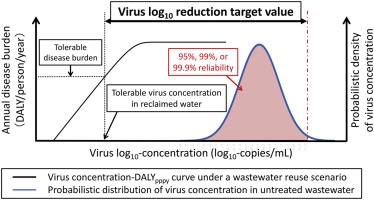当前位置:
X-MOL 学术
›
Water Res.
›
论文详情
Our official English website, www.x-mol.net, welcomes your feedback! (Note: you will need to create a separate account there.)
Target virus log10 reduction values determined for two reclaimed wastewater irrigation scenarios in Japan based on tolerable annual disease burden
Water Research ( IF 12.8 ) Pub Date : 2017-08-26 , DOI: 10.1016/j.watres.2017.08.057 Toshihiro Ito , Masaaki Kitajima , Tsuyoshi Kato , Satoshi Ishii , Takahiro Segawa , Satoshi Okabe , Daisuke Sano
Water Research ( IF 12.8 ) Pub Date : 2017-08-26 , DOI: 10.1016/j.watres.2017.08.057 Toshihiro Ito , Masaaki Kitajima , Tsuyoshi Kato , Satoshi Ishii , Takahiro Segawa , Satoshi Okabe , Daisuke Sano

|
Multiple-barriers are widely employed for managing microbial risks in water reuse, in which different types of wastewater treatment units (biological treatment, disinfection, etc.) and health protection measures (use of personal protective gear, vegetable washing, etc.) are combined to achieve a performance target value of log10 reduction (LR) of viruses. The LR virus target value needs to be calculated based on the data obtained from monitoring the viruses of concern and the water reuse scheme in the context of the countries/regions where water reuse is implemented. In this study, we calculated the virus LR target values under two exposure scenarios for reclaimed wastewater irrigation in Japan, using the concentrations of indigenous viruses in untreated wastewater and a defined tolerable annual disease burden (10−4 or 10−6 disability-adjusted life years per person per year (DALYpppy)). Three genogroups of norovirus (norovirus genogroup I (NoV GI), geogroup II (NoV GII), and genogroup IV (NoV GIV)) in untreated wastewater were quantified as model viruses using reverse transcription-microfluidic quantitative PCR, and only NoV GII was present in quantifiable concentration. The probabilistic distribution of NoV GII concentration in untreated wastewater was then estimated from its concentration dataset, and used to calculate the LR target values of NoV GII for wastewater treatment. When an accidental ingestion of reclaimed wastewater by Japanese farmers was assumed, the NoV GII LR target values corresponding to the tolerable annual disease burden of 10−6 DALYpppy were 3.2, 4.4, and 5.7 at 95, 99, and 99.9%tile, respectively. These percentile values, defined as “reliability,” represent the cumulative probability of NoV GII concentration distribution in untreated wastewater below the corresponding tolerable annual disease burden after wastewater reclamation. An approximate 1-log10 difference of LR target values was observed between 10−4 and 10−6 DALYpppy. The LR target values were influenced mostly by the change in the logarithmic standard deviation (SD) values of NoV GII concentration in untreated wastewater and the reliability values, which highlights the importance of accurately determining the probabilistic distribution of reference virus concentrations in source water for water reuse.
中文翻译:

根据可忍受的年度疾病负担为日本的两种再生废水灌溉方案确定的目标病毒日志10减少值
多种屏障被广泛用于管理中水回用中的微生物风险,其中结合了不同类型的废水处理单元(生物处理,消毒等)和健康保护措施(使用个人防护装备,洗菜等)。达到日志10的性能目标值减少病毒(LR)。LR病毒目标值需要基于在实施水回用的国家/地区的情况下从监控相关病毒和水回用方案中获得的数据计算得出。在这项研究中,我们使用未经处理的废水中的本地病毒浓度和确定的可忍受的年度疾病负担(10 -4或10 -6残疾调整寿命),计算了日本在再生废水灌溉的两种暴露情况下的病毒LR目标值。每人每年的年数(DALY pppy))。使用逆转录-微流定量PCR将未经处理的废水中的三种诺如病毒基因组(诺如病毒基因组I(NoV GI),地理组II(NoV GII)和基因组IV(NoV GIV))定量化为模型病毒,仅存在NoV GII以可量化的浓度。然后从浓度数据集中估算未处理废水中NoV GII浓度的概率分布,并用于计算废水处理中NoV GII的LR目标值。假设日本农民意外摄入回收废水,则NoV GII LR目标值对应于每年可耐受的10 -6 DALY pppy疾病负担分别为95、99和99.9%瓷砖时分别为3.2、4.4和5.7。这些百分位值定义为“可靠性”,代表未经处理的废水中NoV GII浓度分布在废水回收后低于相应的可容忍的年度疾病负担的累积概率。在10 -4和10 -6 DALY pppy之间观察到LR目标值有大约1-log 10的差异。LR目标值主要受未处理废水中NoV GII浓度的对数标准偏差(SD)值的变化和可靠性值的影响,这凸显了准确确定水源水中参考病毒浓度的概率分布的重要性重用。
更新日期:2017-08-28
中文翻译:

根据可忍受的年度疾病负担为日本的两种再生废水灌溉方案确定的目标病毒日志10减少值
多种屏障被广泛用于管理中水回用中的微生物风险,其中结合了不同类型的废水处理单元(生物处理,消毒等)和健康保护措施(使用个人防护装备,洗菜等)。达到日志10的性能目标值减少病毒(LR)。LR病毒目标值需要基于在实施水回用的国家/地区的情况下从监控相关病毒和水回用方案中获得的数据计算得出。在这项研究中,我们使用未经处理的废水中的本地病毒浓度和确定的可忍受的年度疾病负担(10 -4或10 -6残疾调整寿命),计算了日本在再生废水灌溉的两种暴露情况下的病毒LR目标值。每人每年的年数(DALY pppy))。使用逆转录-微流定量PCR将未经处理的废水中的三种诺如病毒基因组(诺如病毒基因组I(NoV GI),地理组II(NoV GII)和基因组IV(NoV GIV))定量化为模型病毒,仅存在NoV GII以可量化的浓度。然后从浓度数据集中估算未处理废水中NoV GII浓度的概率分布,并用于计算废水处理中NoV GII的LR目标值。假设日本农民意外摄入回收废水,则NoV GII LR目标值对应于每年可耐受的10 -6 DALY pppy疾病负担分别为95、99和99.9%瓷砖时分别为3.2、4.4和5.7。这些百分位值定义为“可靠性”,代表未经处理的废水中NoV GII浓度分布在废水回收后低于相应的可容忍的年度疾病负担的累积概率。在10 -4和10 -6 DALY pppy之间观察到LR目标值有大约1-log 10的差异。LR目标值主要受未处理废水中NoV GII浓度的对数标准偏差(SD)值的变化和可靠性值的影响,这凸显了准确确定水源水中参考病毒浓度的概率分布的重要性重用。


























 京公网安备 11010802027423号
京公网安备 11010802027423号